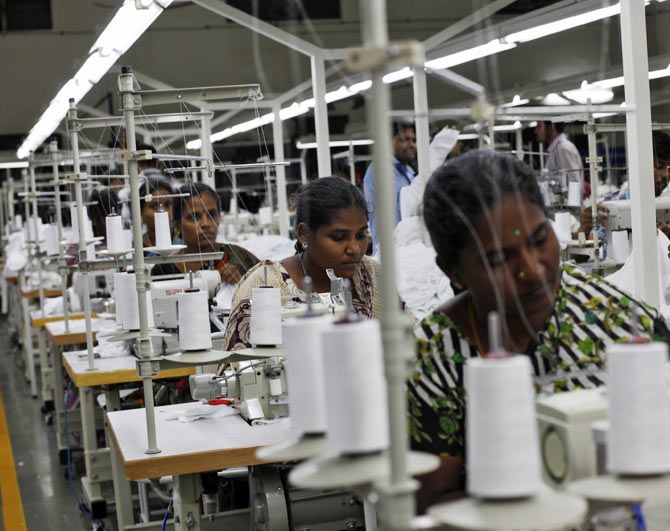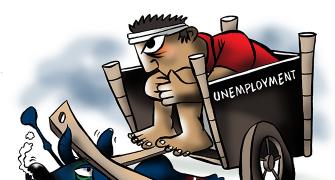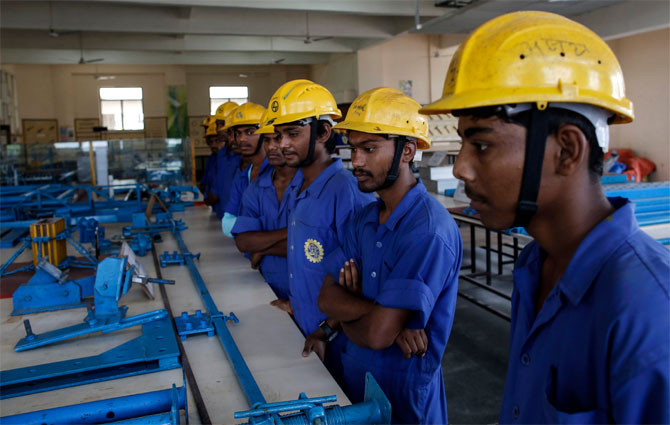'When a new superhero film releases, China creates figurines based on the film and puts them out in the market along with the film's release.'
'Does our domestic manufacturing sector been able to do it so quickly? No.'
'We have a large millennial population and we have to make products that are more in line with the tastes of those people.'
'The MSME sector can win back its customers only this way.'
'When they change with the consumers's needs, there will be a move towards Indian products.'

A report by the Nomura Research Institute on the country's Micro, Small and Medium enterprises says this sector can create an additional 75 lakh (7.5 million) to 1 crore (10 million) employment opportunities in the next 4 to 5 years.
"We have to find out what we can add so that our product is unique so that the world will still buy from us. That's why it is important to reinvent ourselves," Ashim Sharma, below, partner and group head at NRI Consulting & Solutions, Nomura Research Institute, tells Rediff.com's Shobha Warrier.
Any particular reason why NRI Consulting and Solutions chose the MSME sector to do a research for your report?
The reason is, we are in the manufacturing space and the MSME forms one of the sub verticals of the manufacturing sector; in fact a large part.
Your report says the sector has the potential to create up to 1 crore jobs in the next 4 to 5 years, which is a huge number. What should the sector do to tap the potential to achieve this?
One is the market-led approach. It means designing products more in line with consumer needs. Perhaps of the Indian market to begin with. Only that way can you create a pull for the products.
When I say consumers, I mean direct consumers and also businesses of contract manufacturing.
Second is creating a positive advocacy for the products. In some cases, these products suffer from mindset issues like they are not of finest quality, dated and without good finish. So, running an advocacy campaign to remove the negative connotations, is important.
We believe these two factors in addition to the other things that are happening to help the MSME sector, could create 75 lakhs to 1 crore jobs in the 4 to 5 years.
The manufacturing sector is not growing the way it is expected to grow. Is it because of the way cheap Chinese products are dumped here, or due to lack of infrastructure or like many complain, due to the tough labour laws India has?
Yes, those are reasons why the sector is not growing the way everyone wants it to grow.
It is a well-known factor that logistics costs are very high in India, and a major reason for that is that variabilities and lead times are high.
When variabilities and lead times are high, inventory levels (safety stock) need to be high which blocks money in the system.
Naturally, working capital gets blocked.
When logistics costs go up, competitiveness reduces.
It is a fact that a truck on average travels lesser distance in India compared to the rest of the world.
But what we tried to focus on are something very specific like having a market-led approach and a positive advocacy campaign for the products.
We feel this can bring about huge changes in the MSME sector.
Even if you improve logistics and labour laws, unless these two specific areas are not covered, the sector will not have the expected impact.
Many Indians also complain about the lack of quality of Indian products. At the same time, low quality Chinese products are sold in India. Why this attitude towards Indian products?
That's why we stress the need to have a positive advocacy campaign to make consumers realise that what is being made in India is actually good and better than what is coming in as imports.
I will give you the example of toys. When a new superhero film releases, China creates figurines based on the film and puts them out in the market along with the film's release. Does our domestic manufacturing sector been able to do it so quickly? No.
So, what happens is, even if the quality is comparable to what we make here, because children want them at that time, there is a demand for Chinese toys.
We have to admit, China makes all products visually quite attractive and people get naturally swayed by the looks of them.
That's why what we have to do first is, change as per the needs of the consumers. We have a large millennial population and we have to make products that are more in line with the tastes of those people.
And the products have to be refreshed every now and then in line with the trend. That will lead more of a pull for these products.
The quality of our products is much better, in fact. That will be an added advantage.
The MSME sector can win back its customers only this way. When they change with the consumers's needs, there will be a move towards Indian products.
We hear about poor export growth. At the same time, India is a huge market which the MNCs are also very much interested in. Can the MSME sector sustain on Indian market alone?
Of course, exports should be a part of the future of the sector.
If you look at our trade deficit, we are importing a lot, from China especially. At the same time, we cannot ignore the huge market that is there in India.
So, there is a huge opportunity out there which the MSME should tap.
When you talk about manufacturing, are you looking at anything in special which has the potential to grow?
While making this report, we looked at several categories of products; not just one. Our focus was on the clusters that are all over India.
The United Nations Industrial Development Organisation also talks about these clusters, each unique in its own way. We looked at these clusters collectively too.
For example, there are clusters manufacturing sports goods, leather items, artificial jewellery, hosiery, grinders, etc.
We found that if the MSMEs grow, there will be a balanced growth all over India as they are there in rural areas, semi-urban areas and also urban areas.
It is a very balanced growth model. We also found that if most of these clusters grow, they will be substitutes for imports.
You spoke of clusters. One of the most successful cluster was in the textile town of Tirupur in Tamil Nadu which used to dominate exporting hosiery products to the world. Now, Bangladesh has taken over as the dominant exporter of hosiery products.
Do you think the rising labour cost is the reason why India is losing out on such exports?
That could definitely be one of the reasons. Yes, labour costs are going up in India. when new countries with lower labour costs enter the fray, we have to reinvent ourselves on our USP.
Our USP cannot be just the cost.
What we have to do is, we have to find out what we can add so that our product is unique so that the world will still buy from us. That's why it is important to reinvent ourselves.
 You look at the developed world, even today, many things are manufactured in Japan, Korea, Germany and the US. Of course, they could make these products somewhere else also at a cheaper cost.
You look at the developed world, even today, many things are manufactured in Japan, Korea, Germany and the US. Of course, they could make these products somewhere else also at a cheaper cost.
But there is a Unique Selling Proposition around these products which attracts the consumers who are exposed to the whole world. They buy these products even if they are more expensive.
Similarly, cost alone cannot be the USP forever; we have to find another USP for our products.
So, who should advise these manufacturers on creating a new USP?
We have mentioned in our report that we should look at converting customer requirement into product specifications. We should understand the hidden as well as the very visible needs of the customers.
For example, the quality function department in the automotive industry converts customer requirement into product specification. This needs to be done at each cluster and at each product level.
As you do this, you can give strength to your USP.
Of course, you need experts to guide them on each product. The question is, who will fund these activities? There are various ways you could do it. There can be government funding.
But when funding comes free, you won't realise the benefits.
This could also be done on a cost recovery model. Or, it can be a collaboration between the MNCs and the government as MNCs also would prefer to source it locally for certain clusters.
I would not say, this should be a completely free service. When you pay for something, you get more serious about it.
What kind of future do you see for the MSME sector in the next 5 years?
What we found was, if the steps I mentioned earlier are taken, we could see 75 lakhs to 1 crore more jobs getting created. This is a sizeable number. This is the kind of potential we see in the sector.
This will have an added impact on the trade deficit too.
Apart from creating jobs, this will lead to an inclusive, geographically dispersed growth all across the country as MSMEs are spread all across the country. That's why it is very important to focus on this sector.
If these steps are not taken, does this sector have the potential to grow?
If these steps are taken, these are the additional jobs the sector can create. Whatever growth it is experiencing right now, will continue, maybe slightly more or slightly less. But what we are talking about is the extra growth the sector is capable of.
You feel henceforth the focus has to be on the MSME sector.
Yes, this has to be the sector that needs our focus as it can create an inclusive and geographically dispersed growth.








